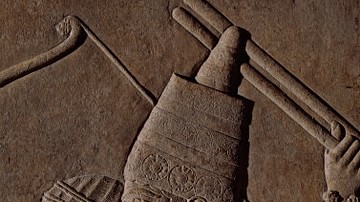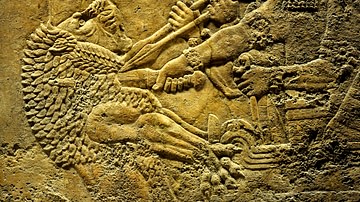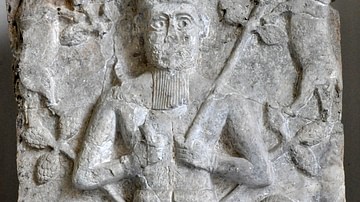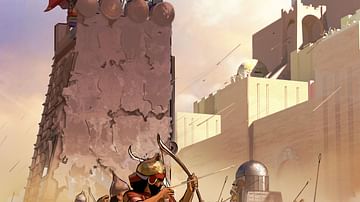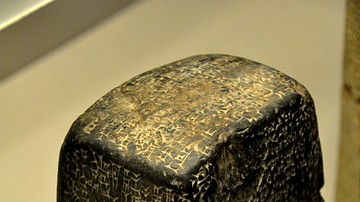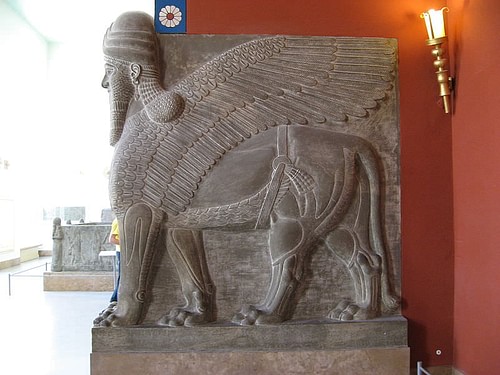
Tukulti-Ninurta I (reigned 1244-1208 BCE) was a king of the Assyrian Empire during the period known as the Middle Empire. He was the son of Shalmaneser I (reigned 1274-1245 BCE) who had completed the work of his father, Adad Nirari I, in conquering and securing the lands that had once been the Kingdom of Mitanni. Tukulti-Ninurta I, therefore, inherited a vast empire that was largely secure. Not content with resting on the achievements of his father and grandfather, Tikulti-Ninurta I expanded Assyria's holdings further, toppled the kingdom of the Hittites, crushed the Nairi people of Anatolia, and enriched the palace treasury with loot from his conquests. An adept warrior and statesman, he was also a literate man who was the first Assyrian king to begin collecting tablets for a library in the capital city of Ashur. He is best known for the sack of Babylon and plundering the sacred temple of the city and has been identified as the king known as Nimrod from the biblical Book of Genesis 10:8-10, who was a great warrior, famous hunter, and Assyrian king. The historian Susan Wise Bauer comments on the Nimrod/Tukulti-Ninurta I identification, writing:
The chronology is difficult, but Tukulti Ninurta is probably the king called Nimrod in Genesis 10:10: a mighty hunter and warrior whose kingdom included Babylon, Erech [Uruk] Akkad, and Nineveh, the same expanse as that claimed by Tukulti-Ninurta for Assyria. Weirdly enough, this Hebrew version of the name of the Assyrian great king has become an English synonym for a foolish and ineffectual man (“What a nimrod!”). The only etymology I can find for this suggests that, thanks to some biblically literate scriptwriter, [the cartoon character] Bugs Bunny once called Elmer Fudd a “poor little Nimrod” in an ironic reference to the “mighty hunter”. Apparently the entire Saturday-morning audience, having no memory of Genesis genealogies, heard the irony as a general insult and applied it to anyone bumbling and Fudd-like. Thus a distorted echo of Tukulti-Ninurta's might in arms bounced down, through the agency of a rabbit, into the vocabulary of the twentieth century (270).
Reign & Early Campaigns
The Kingdom of Mitanni had been conquered by the Hittites under their king Suppiluliuma I (1344-1322 BCE) prior to the rise of the Assyrians. Adad Nirari I and Shalmaneser I, as noted, had secured the region under Assyrian rule by the time Tukulti-Ninurta I took the throne. The Hittites, under their king Tudhaliya IV, were no longer considered the formidable power in the region that they had been in the days of Suppiluliuma I and his son Mursilli II. Tudhaliya IV, wishing to enhance his reputation as a ruler, focused on grand building projects, which included 26 new temples and renovations to his already luxurious palace. At the same time he was channeling funds into urban development. However, his country was suffering a famine which was so serious that he had to write to Egypt asking for grain to keep the people from starving. Further, the Hittite economy was failing and the army had not been paid. When the cities along the western border of his kingdom revolted, Tudhaliya marched out and subdued them, but the effort this took was noted by Tukulti-Ninurta I and, recognizing the weakness of the Hittites, he attacked.
Tudhaliya IV met him on the field of Erbila and, according to a letter which Tukulti-Ninurta I sent to one of his allies, tried to win the battle by trickery, since he feared he could not do so by strength of arms. Tukulti-Ninurta I's letter reads,
Tudhaliya wrote to me, saying, “You have captured merchants who were loyal to me. Come on, let's fight; I have set out against you for battle.”
I prepared my army and my chariots. But before I could reach his city, Tudhaliya the king of the Hittites sent out a messenger who was holding two tablets with hostile words and one with friendly words. He showed me the two with a hostile challenge first. When my army heard about these words, they were anxious to fight, ready to set out at once. The messenger saw this. So then he gave me the third tablet, which said, “I am not hostile to the king of Assur [Ashur], my brother. Why should we brothers be at war with each other?”
But I brought my army on. He was stationed with his soldiers in the city Nihrija, so I sent him a message saying, “I'll besiege the city. If you are truly friendly to me, leave the city at once.” But he did not reply to my message.
So I withdrew my army a little way back from the city. Then a Hittite deserter fled from Tudhaliya's army and reached me. He said, “The king may be writing to you evasively, in friendship, but his troops are in battle order; he is ready to march.”
So I called my troops out and marched against him; and I won a great victory (Bauer, 269).
Tukulti-Ninurta I claimed afterwards to have taken 28,800 Hittite prisoners of war and, while that may be an exaggeration, the historical record supports his claim of the great victory at the Battle of Nihriya in c. 1245 BCE. He could have then pursued Tudhaliya IV and destroyed the remnants of the Hittite army but chose instead to march back to his capital at Ashur with his prisoners and whatever loot there was to be had. While he had been engaged with the Hittites, the city of Babylon in the south moved against Assyrian territories on the border and claimed them. The question of the border states between Babylon and Assyria had been settled by treaty that the Babylonian king now chose to ignore. Regarding this, Bauer writes:
Babylon had had an ambiguous relationship with Assyria for years. Each city had, at various times, claimed the right to rule the other. Babylon and Assur were not only balanced in strength, but also twins in culture. They had once been part of the same empire, under Hammurabi, and the essentially Babylonian stamp on the whole area remained visible. Assyria and Babylon shared the same gods, albeit with occasionally different names; their gods had the same stories; and the Assyrians used Babylonian cuneiform in their inscriptions and annals. This likeness made Assyrian kings generally reluctant to sack and burn Babylon, even when they had the chance. But Tukulti-Ninurta was not much inclined to restraint. He boasted in his inscriptions of the fate of all those who defied him: “I filled the caves and ravines of the mountains with their corpses,” he announces, “I made heaps of their corpses, like grain piled beside their gates; their cities I ravaged, I turned them into ruinous hills” (270).
The Kassite king of Babylon, Kashtiliash IV, took the border regions between Babylon and Assyria and fortified them. He seems to have felt that Tukulti-Ninurta I would be dealing with the Hittites for an extended period and would not concern himself with Babylon or the disputed territories. Bauer comments on this writing, “We know almost nothing about this king, Kashtiliash IV, except that he was a poor judge of men; Tukulti-Ninurta marched down and plundered Babylon's temples” (270). The Assyrian army sacked Babylon and Tikulti-Ninurta I wrote that he faced down the Babylonian king personally in battle and “trod on his royal neck with my feet like a footstool.” With Babylon in ruins, he then took the treasures of the gods, including the statue of the great god Marduk, back to the city of Ashur. He also took with him a large portion of the population as slaves, including the king, who he marched “naked and in chains” to Ashur and then placed an Assyrian official in charge of re-building and governing Babylon. The Assyrian Empire now extended further than it ever had previously under any king, and historians have long claimed that Tukulti-Ninurta I now built his city Kar-Tukulti-Ninurta to celebrate his great victory by creating a new capital city distinct from Ashur.
Kar-Tukulti-Ninurta
The city of Kar-Tukulti-Ninurta (Harbor of Tukulti-Ninurta) was the king's personal project and has long been held to have been initiated after the sack of Babylon. The historian Marc Van De Mieroop writes, “The greatest project was the construction of a new capital city by Tikulti-Ninurta, named Kar-Tukulti-Ninurta, opposite Ashur on the Tigris River. It was built after he had defeated Babylon, and the spoils of that campaign may have helped provide the means” (183). Bauer also cites the same version of events, claiming the city was built following the sack of Babylon. This view of the history of the city, though long held, has been questioned in recent years by scholars who claim the city was among the king's first projects and was only renovated, not initiated, after the fall of Babylon. The historian Alesandra Gilibert writes:
The site was excavated by a German team led by Walter Bachman from October 1913 to March 1914. Fieldwork then resumed in 1986 and again in 1987…Drawing on the results of these excavations and on textual evidence, [we should call] into question two theses that, though rarely properly discussed, have become the communis opinio in scholarly literature. They concern the first decades of the history of the city and can be summarized as follows: 1. Kar Tukulti Ninurta was founded and completed in a relatively short period of time following the military conquest of Babylon, 2. Kar Tukulti Ninurta was conceived as a counterpart to Assur…both theses are based on misinterpretations and false assumptions and hence should be revised (179).
Based on archaeological evidence and the inscriptions found at the site and elsewhere, the city does seem to have been initiated much earlier than the traditional date assigned. The accepted story of the city rising after the fall of Babylon comes from inscriptions found on buildings in the ruins of Kar Tukulti Ninurta, in the king's royal inscriptions, and on the supposition that, after the sack of Babylon, the king wanted to separate himself from those in Ashur who did not approve of his campaign and so built a new capital. The inscriptions in the city, however, are all found on buildings which were renovated, not built, after the fall of Babylon, and the older part of the city pre-dates Babylon's fall in c. 1225 BCE. It seems more likely that the new city, whose palace Tukulti-Ninurta I referred to as “my royal dwelling”, was built early in his reign not to replace Ashur as the capital but simply to complement it. Records indicate that the same officials who worked in the administrative offices in Ashur also worked across the river in the offices at Kar-Tukulti-Ninurta, and so the claim that the new city was built to replace the old capital is untenable. The inscriptions of the king claiming it was built quickly after the fall of Babylon seem more like political propaganda than historical truth and most likely actually refer to the renovations to the city and not to its founding. These inscriptions make clear how complete Tukulti-Ninurta I's victory was over the Kassites of Babylon and how this victory should be remembered by those visiting the city. These writings correspond to another work commissioned by the king, the Tukulti Ninurta Epic, which justifies his campaign against Babylon and the looting of the temples.
The Tukulti-Ninurta Epic
The historian Stephen Bertman writes, “In literature, Tukulti-Ninurta's victory over Kashtiliash was celebrated in an epic, the so-called Tikulti-Ninurta Epic, the only Assyrian one we possess” (108). In this poem, the king claims that he had no choice but to sack Babylon because the Kassite king had broken the laws ordained by the gods. Commenting on this, the historian Christoph O. Schroeder writes:
The Assyrian Tukulti-Ninurta Epic's purpose is to give a theological legitimation for the destruction of Babylon by the Assyrian king…It intends to justify the city's destruction as the outcome of a just war. To achieve this, it portrays Kashtiliash IV, the Babylonian king, as a breaker of oaths and the violator of the parity-treaty that had been the basis of the relations between Assyria and Babylon since the time of the king's fathers (147).
The poem begins with Tikulti-Ninurta I addressing the sun god Shamash saying, “I respected your oath, I feared your greatness” and then going on to explain how the king of Babylon had not done so - “He had no fear of your oath, he transgressed your command, he schemed an act of malice” - and so Tikulti-Ninurta I had only been doing the will of the gods when he sacked the city and took the treasures of the temple back to Ashur. Even though it was true that Kashtiliash IV had initiated hostilities, the people of the land, both Babylonians and Assyrians, felt the king's treatment of the city was too harsh for the transgression of claiming the border territories and breaking the treaty. Bauer writes:
Babylon itself had been shocked by the plunder of the temples: “He put Babylonians to the sword,” the Babylonian Chronicle says, “the treasure of Babylon he profanely brought out, and he took the great lord Marduk off to Assyria.” Nor had the destruction gone over well with the devout in his own land. The Assyrian epic that Tukulti-Ninurta commissioned to celebrate the victory over Babylon has an unmistakably defensive tone; it goes to great lengths to explain that Tukulti-Ninurta really wanted to have peace with Babylon and tried his best to be friends with Kashtiliash, only the Babylonian king insisted on coming into Assyrian territory to thieve and burn, which is why the gods of Babylon deserted the city and left it for punishment to the Assyrians. Clearly the great king was under pressure to explain not only why he sacked Babylon, but why he took its sacred images back to his own capital. The explanation didn't convince, and Tukulti-Ninurta's sacrilege brought about his end (271).
Centuries later, the Assyrian king Sennacherib would sack Babylon and his son Esarhaddon would explain the city's fate using this same theological justification. Esarhaddon, however, had been a young prince at the time of his father's conquest of Babylon and clearly had had nothing to do with it. His explanation that the gods had destroyed Babylon because of the sins of the people, which left out any mention of the role his father played in the destruction of the city, seemed to make sense in that he was re-building Babylon following its fall and had played no part in its destruction. Tukulti-Ninurta I's inscription was not accepted because the people knew what he had done and how he had personally profited from the wealth stolen from the gods. Whether Kar-Tukulti-Ninurta was built earlier or later in his reign, it was lavishly renovated with wealth from the sack of Babylon, and the king retreated to his royal dwelling and left the politics of Ashur to his court administrators. It has long been surmised that he did so because the tide of popular opinion had turned against him because of his treatment of Babylon.
Death & Legacy
The Babylonian Chronicles report that, “As for Tukulti-Ninurta, who had brought evil upon Babylon, his son and the nobles of Assyria revolted and they cast him from his throne and imprisoned him in his own palace complex and then killed him with a sword.” His death plunged the country into a chaos of civil war from which his son Ashur-Nadin-Apli, generally understood as his assassin or at least a primary conspirator, took the throne and restored order. Still, the country fell into a kind of stasis in which it neither declined nor evolved. The entire region c. 1200 BCE suffered significantly in the so-called Bronze Age Collapse but Assyria would remain relatively intact; even so, the empire suffered after the death of Tukulti-Ninurta I and no king would rise to lead the country forward until the reign of Tiglath Pileser I (1115-1076 BCE).
Although he had ruled successfully for 37 years, Tukulti-Ninurta I's decision to sack Babylon, and his subsequent assassination, were what he was known for afterwards, thanks to the work of the Babylonian scribes who wrote the chronicles. His legacy, however, could be greater than they imagined when they wrote of him centuries ago. Van De Mieroop notes that, “Babylon's culture had an impact on the entire Near Eastern world…Tukulti Ninurta I, for example, after sacking Babylon, took home literary tablets as booty. He may thus have laid the foundation of a royal library in Assyria filled with Babylonian manuscripts. These influenced local authors” (179). These Assyrian authors would transcribe works such as the myth of Adapa, the inscriptions of Sargon the Great, the Epic of Gilgamesh, the myths of the gods of Babylon specifically and Sumer in general, and, in doing so, passed on these stories to other generations in Assyria. As the Assyrian Empire grew larger and conquered other territories, the literature of Babylon spread throughout their territories, influencing the cultures and literary traditions of the ancient world.
